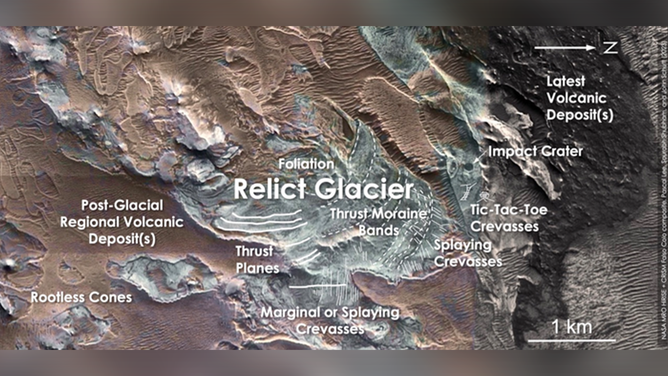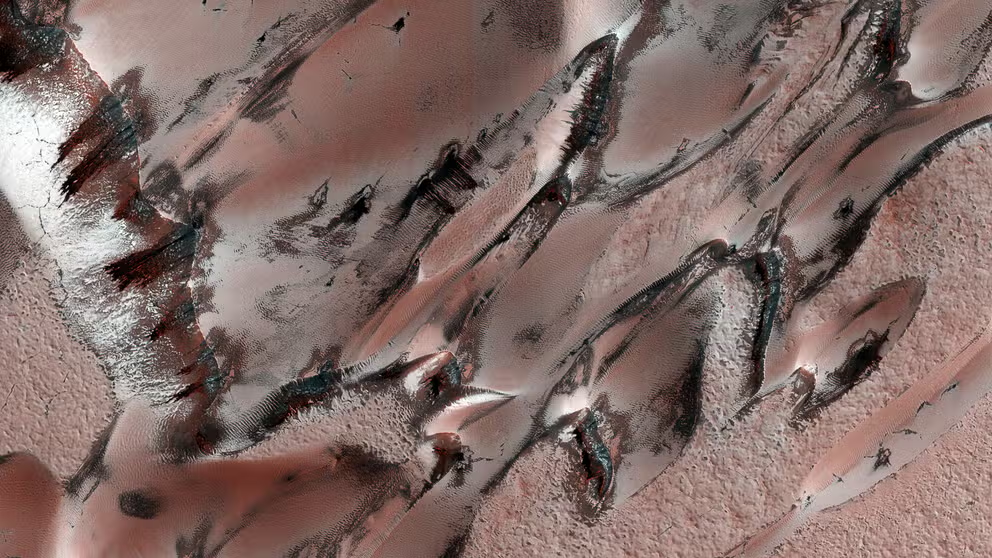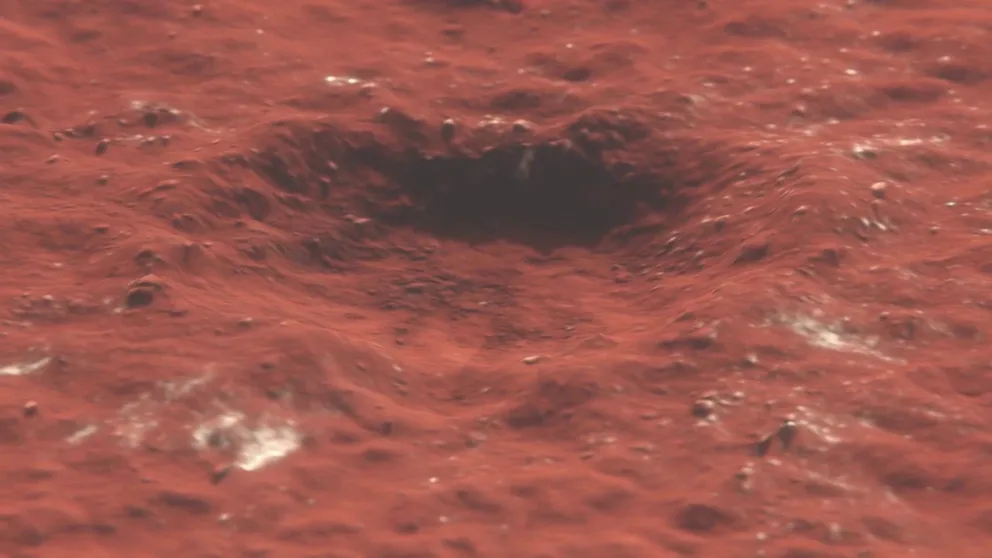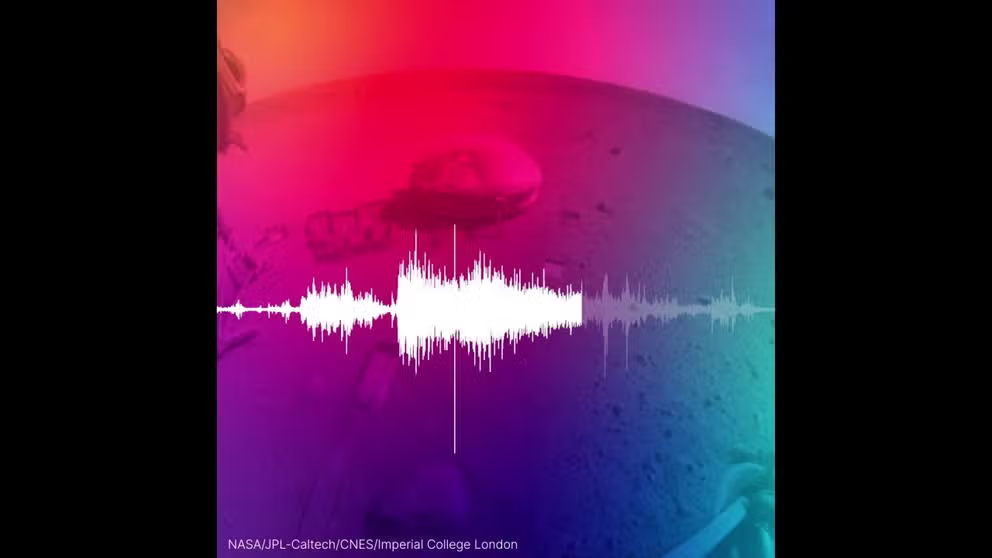Discovery of relict glacier near Mars’ equator suggests ice may still be present at low latitudes
The newly discovered glacier is estimated to be 3.7 miles long and about 2.5 miles wide. It's also estimated that the glacier is about a mile high, which suggests that Mars' recent history may have been much wetter than previously thought and could have implications for understanding the Red Planet's habitability.
'Wintry' scenes from Mars: How the Red Planet sometimes looks a little white
It's not just Earth that boasts snowfall. Mars gets snow sometimes too, only there, it's frozen carbon dioxide, not water. Peek at some of the "snowy" scenes from our distant planetary neighbor.
The discovery of a relict glacier near Mars' equator raises questions among the scientific community about the possibility that ice may still exist in shallow depths in the area, which would have significant implications for the future human exploration of the Red Planet.
The groundbreaking announcement of the discovery was made at the 54th Lunar and Planetary Science Conference held in The Woodlands, Texas, this week.

Interpretation of the "Relict Glacier" features.
(Pascal Lee)
According to the SETI (Search for Extraterrestrial Intelligence) Institute, images show light-toned deposits (LTDs) consisting mainly of light-colored sulfate salts but also show glacier features, including crevasse fields and moraine bands.
The newly discovered glacier is estimated to be 3.7 miles long and about 2.5 miles wide. It's also estimated that the glacier is about a mile high, which suggests that Mars' recent history may have been much wetter than previously thought and could have implications for understanding the Red Planet's habitability, according to the SETI Institute.
"What we've found is not ice, but a salt deposit with the detailed morphologic features of a glacier. What we think happened here is that salt formed on top of a glacier while preserving the shape of the ice below, down to details like crevasse fields and moraine bands," Dr. Pascal Lee, a planetary scientist with the SETI Institute and the Mars Institute and lead author of the study, said in a news release.
SEE MARTIAN SUN RAYS: 'FIRST TIME SUN RAYS HAVE BEEN SO CLEARLY VIEWED ON MARS,' NASA SAID
Flyover of Mars impact from a meteoroid
This animation depicts a flyover of a meteoroid impact crater on Mars that's surrounded by boulder-size chunks of ice. The animation was created using data from the High-Resolution Imaging Science Experiment (HiRISE) camera aboard NASA's Mars Reconnaissance Orbiter. (NASA/JPL-Caltech/University of Arizona)
The study's findings imply that the presence of volcanic materials across the region shows how the sulfate salts may have formed and preserved the glacier's imprint under it. The SETI Institute said when pyroclastic materials such as volcanic ash, pumice and hot lava come in contact with the ice, the sulfate salts may form and build up into a hardened, crusty salt layer.
As erosion removed the volcanic materials, the layer of sulfates mirroring the glacier ice under it eventually became exposed, which explains how the salt deposit is now visible.
"Glaciers often present distinctive types of features, including marginal, splaying, and tic-tac-toe crevasse fields, and also thrust moraine bands and foliation. We are seeing analogous features in this light-toned deposit, in form, location, and scale. It's very intriguing," said John Schutt, a geologist at the Mars Institute, experienced icefield guide in the Arctic and Antarctica and co-author of this study.
NASA'S MARS ROVER REVEALS DIVERSITY OF WILD WEATHER ON THE RED PLANET
LISTEN: Mars Insight lander records meteor crashing into Red Planet
This video includes a seismogram and sonification of the signals recorded by NASA's InSight Mars lander, which detected a giant meteoroid strike on Dec. 24, 2021, the 1,094th Martian day, or sol, of the mission. (Credits: NASA/JPL-Caltech/CNES/Imperial College London.)
The study's authors say that the glacier's features, the associated sulfate salt deposits and the overlying volcanic materials are sparsely cratered by impacts and suggest it must be geologically young.
"We've known about glacial activity on Mars at many locations, including near the equator in the more distant past. And we've known about recent glacial activity on Mars, but so far, only at higher latitudes. A relatively young relict glacier in this location tells us that Mars experienced surface ice in recent times, even near the equator, which is new," Lee said.
LISTEN TO A MARTIAN DUST DEVIL: THE FIRST RECORDING EVER COULD BE THE KEY TO FUTURE MISSIONS
Mars rover Curiosity celebrates ten years
Mars rover Curiosity has been exploring the Red Planet for a decade (NASA)
But it remains to be seen if water remains under the deposit or has disappeared. If scientists discover that ice has been preserved at shallow depths in the lower latitudes on Mars, that could have significant implications for future exploration of the Red Planet.
"The desire to land humans at a location where they might be able to extract water ice from the ground has been pushing mission planners to consider higher latitude sites. But the latter environments are typically colder and more challenging for humans and robots. If there were equatorial locations where ice might be found at shallow depth, then we'd have the best of both environments: warmer conditions for human exploration and still access to ice," said Lee.



